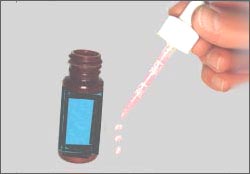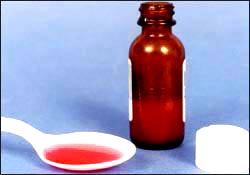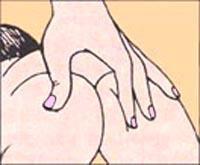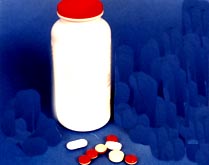타이레놀(아세트아미노펜제)로 해열시키는 방법 How to use Tylenol (Acetaminophen) for treatment of fever
|

사진 21. 나이나 체중에 따라 타이레놀 적제(방울약)로 해열시킬 수 있다.
요즘 타이레놀 적제(방울약)은 미국에서 더 이상 제조 하지 않는다.
Copyright ⓒ 2011 John Sangwon Lee, MD, FAAP

사진 22. 나이나 체중에 따라 타이레놀 시럽(엘릭서)으로 해열시킬 수 있다.
Copyright ⓒ 2011 John Sangwon Lee, MD., FAAP

그림 24. 그 때 상황이나 나이나 체중에 따라 경구용 아세트아미노펜 대신 아세트아미노펜 좌약으로 해열시킬 수 있다. 그러나 아세트아미노펜 좌약으로 해열 시킬 때 그 좌약의 흡수가 잘 되는지 안 되는지 알 수가 없다. 그래서 아세트아미노펜 좌약으로 해열시키는 대신 될 수 있는 한 경구용 아세트아미노펜으로 해열시키는 것이 더 좋다.
Copyright ⓒ 2011 John Sangwon Lee, MD., FAAP

사진 23. 나이나 체중에 따라 타이레놀 츄어블정과 타이레놀 알약으로 해열시킬 수 있다.
Copyright ⓒ 2011 John Sangwon Lee, MD, FAAP
- 아이들에게 갑자기 열이 나면 부모들은 많이 걱정한다.
- 고열이 자녀에게 나면 대부분의 부모들은 당황한다.
- 그렇다고 해서, 미열이든 고열이든 자녀에게 열이 날 때 무턱대고 타이레놀이나 아이브프로펜제나 모트린 등 해열제로 해열 시켜서는 안 된다.
- 아이에게 열이 난다고 해서 부모 마음대로 집에서 무턱대고 해열제로 계속 해열시켜서는 절대로 안 되는 이유는 여러 가지가 있다.
- 해열을 시키기 전 어떤 종류의 감염병이나 어떤 병이 신체 어느 계통의 어는 기관에 생겼는지 어떤 종류의 병원체 감염으로 생긴 감염병으로 열이 나는지 또는 다른 어떤 원인으로 열이 나는지 추정진단 해야 한다.
- 그러나 의사도 부모가 열나게 하는 병을 언제든지 쉽게 추정 진단하기가 어렵다. 추정 진단 하기 전에 의사의 도움 없이 부모의 마음대로 해열제로 해열 시켜서는 안 된다.
- 환아가 감기나 그 외 다른 경미한 바이러스 호흡기 감염병에 걸려서 미열이 난다고 부모와 환아의 단골 소아과 의사가 다 같이 추정 진단하고 그 미열을 해열제로 해열 시켜도 문제가 없다고 결정 했을 때 가정에서 의사의 지시에 따라 부모가 환아의 열을 해열제로 해열시킬 수 있다.
- 이 말은 사실은 의사에게 문의하지 않고 부모가 부모의 마음대로 자녀에게 나는 열을 집에서 해열제로 해열시켜서는 안 된다는 말이다.
- 어떤 원인이나 병으로 열이 나는지 확실히 알지도 못하고 그 열이 나는 원인이나 병을 어느 정도로 추정진단하지 못하거나 때로는 추정 진단을 하지도 않고 열을 나게 하는 원인이나 병이 무엇인지 확실히 진단하기도 전 타이레놀 등 해열제로 해열시키면 열은 잠시 동안 떨어질 수 있다.
- 타이레놀은 해열작용도 있고 진통작용도 있기 때문에 타이레놀로 해열시키면 그 때 있던 통증도 없어질 수 있기 때문에 타이레놀로 해열 시킬 때 열도 떨어지고 통증도 경감될 수 있다.
- 그래서 타이레놀 등 진통 해열제로 치료를 받는 당시 전반적으로 열 통징 등 증상 징후가 좋아질 수 있다. 그렇지만, 열이 나게 한 원래의 원인이나 감염병 등은 치료되지 않는다.
- 그리고 열나게 한 감염병이나 다른 병 등을 조기 확진하고 치료하는데 더 혼동될 수 있고 병의 초기 당계에 더 확실하게 병을 확실히 진단하는 데 지연될 수 있다.
- 열을 나게 하는 원인이나 병을 확실히 모르고 타이레놀 등 다른 해열제로 무턱대고 해열 시켜선 안 된다는 말이다.
- 타이레놀 알레르기가 있는 아이에게 열이 나면 타이레놀로 해열시킬 수 없고,
- 간에 어떤 이상이 있는 아이에게 열이 나면 타이레놀로 해열시켜서는 안 된다.
- 열이 난다고 해서 그 열을 해열제로 바로 해열시키는 치료방법은 이상적인 치료방법이 아니다.
- 결론을 내리면, 열이 날 때 의사의 지시가 없이 타이레놀이나 다른 종류의 해열제로 부모 마음 대로 해열 시켜서는 안 된다.
- 때로는 타이레놀로 해열시키는 대신 모트린 등 아이부프로펜제(Ibuprofene)로 해열시킬 수 있다.
- 소아청소년과에서 열이 날 때 해열제로 타이레놀이나 아이부프로펜제를 가장 많이 쓴다.
의사가 해열제로 해열시켜도 된다고 지시하면 다음과 같이 타이레놀 등 해열제로 해열시킬 수 있다.
타이레놀 참조.
- 체온이 섭씨 38°(화씨 100°)나 그 이상 되면 열이 난다고 할 수 있다.
- 열이 난다고 단정하기 전에 가능하면 체온을 다시 한두 번 재어 실제로 체온이 정상 체온보다 더 높고 열이 나는지, 또 열이 얼마나 나는지 다시 한 번 확인하는 것이 좋다.
- 열이 확실히 난다고 판단하면 어떤 감염병으로 열이 나는지 또 어떤 병원체나 그 외 어떤 원인으로 열이 나는지, 어떻게 치료를 할 것인가, 어떤 해열제로, 어떻게 해열 시킬 것인가를 결정한다.
- 의사의 진찰과 진단 치료를 받기 전에 집에서 해열을 시키려면 어떤 해열제로 해열시킬 것인가 또는 해열제 말고 다른 방법으로 해열시킬 것인가를 결정한다.
- 만일 해열제로 해열 시키려면 타이레놀, 모트린, 부루펜, 애드빌, 또는 아스피린 등 여러 종류의 해열제들 중 어떤 종류의 해열제로 해열시키는 것이 좋은가를 결정한다.
- 해열제인 타이레놀이나 다른 종류의 해열제의 형태에는 엘릭서, 적제(방울액), 씹어서 먹을 수 있게 만든 츄어블 정(Chewable tablet), 주니어 소아용 알약(Junior tablet), 성인용 알약, 캡슐 등 여러 종류가 있다. 그 중 어떤 종류의 형태의 해열제로 해열 시킬 것인가를 결정한다.
- 만일 타이레놀 해열제로 해열시키기로 결정했다면 어떤 형태의 타이레놀제로 해열시킬 것인가 결정한다.
- 그 다음 타이레놀 해열제의 1회 용량은 얼마가 적절한가를 결정한다.
- 타이레놀 해열제에는
- 타이레놀 엘릭서,
- 타이레놀 적제액(방울액),
- 타이레놀 츄어블 정(Tylenol chewable tablets),
- 타이레놀 주니어 소아용 알약,
- 타이레놀 성인용 알약,
- 타이레놀 캡슐 등 여러 형태의 타이레놀 해열제가 있다.
- 타이레놀 적제 액 0.8cc(㎖)에 아세트아미노펜 성분이 80mg이 들어 있다(참고; 제약회사마다 단위 용적 타이레놀 용량이 다를 수 있다. 아세트아미노펜은 타이레놀의 학명이다.)
- 타이레놀 적제액(Tylenol drop)으로 영유아의 열을 해열시킬 때는 해열 시킬 수 있는 타이레놀 일회분 용량은 다음과 같다.
- 1세 유아에게는 1 드로퍼플(Dropful)(0.8㎖),
- 2세 유아에게는 2 드로퍼플(1.6㎖),
- 3세 유아에게는 3 드로퍼플(2.4㎖)이 1회분 타이레놀 해열제의 용량이다.
- 그 1회분 용량을 4~6시간마다 투여해서 해열시킬 수 있다.
- 타이레놀 드로퍼플을 신생아들이나, 영아들, 또 유아들의 열을 해열시킬 때 의사가 처방한 대로 쓸 수 있다.
- 학령기 아이들, 사춘기 아이들을 또는 성인들의 열을 해열시킬 때도 쓸 수 있다.
- 1∼3세의 유아들에게 나는 열을 해열시킬 때는 타이레놀 엘릭서를 주로 선택해서 쓸 수 있다.
- 타이레놀 엘릭서 5㏄(1 티스푼)에는 아세트아미노펜 성분이 160㎎ 들어 있다.
- 열이 나는 1세 유아에게는 타이레놀 엘릭서의 2분의 1 티스푼 정도(한 티스푼은 5cc이다.)
- 2세 유아에게는 1 티스푼,
- 3세 유아에게는 1 티스푼 반 정도를 1회분 용량으로 경구로 해열시킬 수 있다.
- 타이레놀 해열제로 해열시킬 때에는 체중 매 ㎏당 타이레놀 10~15㎎을 1회분 용량으로 계산해서 해열시킬 수 있다.
- 소아용 타이레놀 츄어블 1정 속에 아세트아미노펜 해열제의 성분이 80㎎ 들어 있다.
- 소아용 타이레놀 츄어블 정으로 해열시킬 때 1회분 용량은 다음과 같다.
- 1세 유아에게는 소아용 타이레놀 츄어블 1정,
- 2세 유아에게는 소아용 타이레놀 츄어블 2정,
- 3세 유아에게는 소아용 타이레놀 츄어블 3정,
- 4세 유아에게는 소아용 타이레놀 츄어블 4정을 1회분 해열제 용량으로 해열시킬 수 있다.
- 타이레놀 알약을 삼킬 수 있는 4∼6세 유아들이나 그 이상 유아들이나 학령기 아이들, 또는 사춘기 아이들에게 나는 열을 해열시킬 때는 성인용 타이레놀 325㎎정을 1회분으로 해열시킬 수 있다.
- 4∼6세 유아들이나 그 이상 아이들의 열을 해열시킬 때는 성인용 타이레놀 325㎎ 용량 1정을 1회분으로 해열시킬 수 있다.
- 8∼10세나 그 이상 된 학령기 아이에게는 타이레놀 325㎎ 2정을 1회분 용량으로 해열 시킬 수 있다.
- 이상에서 제시한 타이레놀 해열제의 1회분 용량은 평균 1회분 치료 용량이다.
- 타이레놀의 1회분 치료 용량은 아이의 나이 및, 또는 체중에 따라 의사가 처방한 대로 주어 해열시키는 것이 원칙이다.
- 최근에 성인용 타이레놀 1회분 용량을 전에 권장한 용량보다 더 낮은 용량으로 치료하라고 권장한다.
- 타이레놀 해열제로 해열시킬 때 부작용이 생길 수 있으나 적당한 용량으로 적절히 해열시킬 때는 부작용이 아주 드물다.
- 타이레놀 해열제를 과량으로 사용할 때나 장기간 사용할 때는 간(肝)에 해가 될 수 있고 치료 용량 이상으로 과량 사용하면 사망할 수 있다.
- 간에 이상이 없을 때도 타이레놀 해열제를 용법에 따라 의사의 지시에 따라 잘 쓰면 타이레놀은 임상적으로 아주 좋은 해열제이고 진통제이다.
- 경구용 타이레놀로 해열시킬 때 구토하거나 다른 이유로 소화가 안 될 때는 경구용 아세트아미노펜(타이레놀 성분)으로 해열시키는 대신 아세트아미노펜 좌약으로 해열시킬 수 있다.
- 아세트아미노펜 좌약 1회분 용량은 경구용 타이레놀의 1회분 용량과 똑같다.
- 아세트아미노펜 좌약 한 개 속에 들어 있는 아세트아미노펜의 용량은 다음과 같다.
- 즉 좌약 한 개 속에 80㎎, 120㎎, 160㎎, 320㎎ 또는 650㎎이 각각 들어 있다.
- 아이의 나이와 체중에 따라 아세트아미노펜 좌약의 일회분 치료 용량을 결정한다.
- 경우에 따라 타이레놀과 아스피린, 타이레놀과 부루펜 또는 타이레놀과 애드빌을 동시에 주어 해열시킬 수 있으나 이런 해열제로 해열시키는 데 대해서는 찬반설이 있다.
- 가능하면 한 가지의 해열제 성분이 든 해열제로 해열시키는 것이 더 좋다.
- 의사의 지시와 필요에 따라 타이레놀의 1회분 해열치료 용량을 매 4~6시간마다 주어 해열시킬 수 있다.
- 타이레놀로 해열 치료할 때도 원칙적으로 의사의 지시에 따라서 치료해야 한다.
타이레놀 해열제로 한두 번 해열시킨 후
① 열이 떨어지지 않고 계속 열 날 때,
② 아이가 계속 아플 때,
③ 타이레놀 해열제로 한두 번 해열 치료를 한 후에 더 아플 때,
④ 부작용이 생길 때,
⑤ 부작용이 생겼다고 의심할 때,
⑥ 그 병을 타이레놀 해열제로만 치료하는데 확신을 갖지 못하고 걱정이 되면
⑦ 타이레놀 해열제로 처음부터 해열치료를 하지 말고,
⑧ 계속 해열 치료를 하지도 말고 의사에게 바로 문의 진찰 진단 치료를 받아야 한다.
- 경구용 아세트아미노펜제와 항문용 아세트아미노펜(Oral acetaminophen and rectal acetaminophen)제에 관한 최근 연구결과가 나왔다. 그 연구를 소개하면.
- 소아들의 열을 해열시키는데 경구용 아세트아미노펜제를 이용할 수 있고 항문용 좌약 아세트아미노펜제를 이용할 수 있다.
- 그러나 항문용 아세트아미노펜제로 해열을 시킬 때 항문 속에 넣은 아세트아미노펜제가 체내로 잘 흡수되지 않을 수 있고 일정하게 흡수되지 않을 수 있기 때문에 아세트아미노펜에 중독될 수 있고 바라는 만큼 아세트아미노펜제 해열 효과를 보기가 어려울 수 있다.
- 그런 이유로 미소아과학회에서는 항문용 아세트아미노펜제 좌약으로 소아의 열을 해열시키는 것을 장려하지 않는다.
| The new lower concentration of 160 mg/5 mL that is appearing in stores will affect the amount of liquid acetaminophen given to an infant, especially if the caregiver has been using the more concentrated 80 mg/0.8 mL or 80 mg/1 mL formulation. The newer product comes with an oral syringe instead of a dropper to measure the precise dose of liquid. Jan 5, 2012 By: Contemporary |
소스: Archives of Pediatrics & Adolescent Medicine November 2008.
| 최신 뉴스
Infant-Strength Acetaminophen to Be Discontinued, Just One Children’s Concentration Will Be Available 해열 진통시키는 데 주로 많이 썼던 영아용 농도 아세트아미노펜제 즉, 80 mg/0.8 mL 액제는 더 이상 제조하지 않고 그냥 소아용 농도 아세트아미노펜, 즉 160mg/5mL 액제만 미국에서 제조한다. |
How to use Tylenol (Acetaminophen) for treatment of fever

Photo 21. Depending on age or weight, Tylenol can be used to reduce fever. Copyright ⓒ 2011 John Sangwon Lee, MD, FAAP

Picture 22. Depending on your age or weight, you can use Tylenol syrup to relieve fever. Copyright ⓒ 2011 John Sangwon Lee, MD, FAAP

Picture 23. Depending on your age and weight, you can use Tylenol chewable tablets and Tylenol tablets to relieve fever. Copyright ⓒ 2011 John Sangwon Lee, MD, FAAP

Figure 24. At that time, depending on the situation, age or weight, acetaminophen suppositories can be used to relieve fever instead of oral acetaminophen. However, when antipyretic with acetaminophen suppository, it is not known whether the suppository is absorbed well or not. Therefore, instead of using acetaminophen suppositories to relieve fever, it is better to use oral acetaminophen if possible. Copyright ⓒ 2011 John Sangwon Lee, MD., FAAP
• Parents are very worried when their children have a sudden fever.
• When a child has a high fever, most parents panic. • However, when your child has a fever, whether it is a mild fever or a high fever, do not blindly give Tylenol, Ibprofen, or Motrin to relieve fever with fever-reducing drugs.
• There are a number of reasons why a child should never have a fever at home and should never be blindly given a fever-reducing medication at home.
• Before performing fever relieving, it is necessary to presume diagnosis of what kind of infectious disease or disease occurred in which system and which organ of the body, what kind of pathogenic infection causes fever, or any other cause of fever.
• However, it is difficult for doctors to easily presume diagnosis at any time the disease that makes parents feverish. Before the presumptive diagnosis, the parent should not give fever-reducing drugs at will without the help of a doctor.
• When both the parent and the child’s regular pediatrician presume that the child has a low-grade fever due to a cold or other mild viral respiratory infection, and decides that there is no problem even if the low-grade fever is treated with an antipyretic drug, follow the doctor’s instructions at home. Parents can relieve fever in their child with antipyretic drugs.
• What this means is that parents should not use antipyretics at home to treat their child’s fever at their own will without consulting a doctor.
• Tylenol, etc., without knowing for certain what cause or disease the fever is, and without a presumptive diagnosis of the cause or disease of the fever, or even without a presumptive diagnosis, and without a definitive diagnosis of the cause or disease causing the fever. If you use an antipyretic agent, the fever may drop for a while.
• Tylenol has antipyretic and analgesic effects, so if you use Tylenol to relieve fever, the pain at that time can also go away. Therefore, when you use Tylenol to reduce fever, the fever can drop and the pain can be relieved.
• So, when you are treated with analgesic and antipyretic drugs such as Tylenol, symptoms such as fever and pain may improve overall. However, the original cause or infectious disease that caused the fever is not treated.
• In addition, early diagnosis and treatment of the infectious disease or other disease that caused fever may be more confused and delayed in diagnosing the disease more reliably in the early stages of the disease.
• This means that you should not blindly treat fever with other antipyretic drugs such as Tylenol without knowing the cause or disease that causes fever.
• If a child with a Tylenol allergy has a fever, Tylenol cannot relieve the fever;
• A fever in a child with any liver problem should not be treated with Tylenol.
• Just because you have a fever, a treatment method that immediately relieves the fever with an antipyretic agent is not an ideal treatment method.
• In conclusion, parents should not voluntarily administer Tylenol or other antipyretic drugs to relieve fever without a doctor’s advice.
• Sometimes, instead of treating fever with Tylenol, you can use Ibuprofen, such as Motrin.
• In pediatrics, Tylenol or ibuprofen are the most commonly used antipyretics for fever. If your doctor instructs you to use antipyretics, you can use antipyretics such as Tylenol as follows.
See Tylenol.
• A fever is defined as a body temperature of 38°C (100°F) or higher.
• Before concluding that you have a fever, it is a good idea to take your body temperature once or twice if possible to confirm that your body temperature is actually higher than normal and you have a fever and how much you have.
• If it is determined that you have a fever, you decide what infectious disease causes the fever, what pathogen or other cause causes the fever, how to treat it, what antipyretic agent, and how to treat it.
• If you want to relieve fever at home before consulting your doctor and getting diagnostic treatment, decide which antipyretic or another method other than antipyretic.
• If you want to treat fever with an antipyretic drug, decide which kind of antipyretic drug is the best among several antipyretic drugs such as Tylenol, Motrin, Ibuprofen, Advil, or Aspirin.
• Tylenol, an antipyretic drug, and other antipyretic drugs come in several forms, such as elixirs, red tablets (drops), chewable tablets, junior tablets, adult tablets, and capsules.
Decide which type of antipyretic agent to treat fever among them.
• If you decide to treat fever with Tylenol, decide what type of Tylenol you will treat.
• Then determine what is appropriate for a single dose of Tylenol antipyretic.
Tylenol antipyretic
o Tylenol Elixir,
o Tylenol drip (drop),
o Tylenol chewable tablets,
o Tylenol Junior Pediatric Tablets;
o Tylenol adult tablets;
o There are several types of Tylenol antipyretics, including Tylenol capsules.
• 0.8cc (ml) of Tylenol drip contains 80 mg of acetaminophen (Note; the unit volume of Tylenol may vary by a pharmaceutical company. Acetaminophen is the scientific name of Tylenol.)
• When using Tylenol drop to relieve fever in infants and toddlers, the dosage of Tylenol per serving is as follows.
o For 1-year-old infants, 1 Dropful (0.8ml),
o 2 drop purple (1.6 ml) for 2-year-old infants,
o For 3-year-old infants, 3 Drop Purple (2.4 ml) is the dosage of Tylenol antipyretic in a single dose.
• The single dose can be administered every 4 to 6 hours to relieve fever.
• Tylenol Drop Purple can be used as prescribed by a doctor to relieve fever in newborns, infants, and infants.
• It can also be used to relieve fever in school-age children, adolescents or adults. • For infants aged 1 to 3 years, I can mainly use Tylenol Elixir for fever relief.
• Tylenol Elixir 5cc (1 teaspoon) contains 160mg of acetaminophen.
• For 1-year-old infants with a fever, about 1/2 teaspoon of Tylenol Elixir (one teaspoon is 5cc).
• 1 teaspoon for 2 year olds;
• For infants 3 years of age, one and a half teaspoons can be administered orally to relieve fever.
• When reducing fever with Tylenol antipyretics, 10~15 mg of Tylenol per kg of body weight can be calculated as a single dose to relieve fever.
• One tablet of Tylenol for children contains 80 mg of acetaminophen antipyretic.
• When relieving fever with pediatric Tylenol chewable tablets, the dose per serving is as follows.
o For 1-year-old infants, 1 Pediatric Tylenol Chewable;
o For infants 2 years of age, 2 pediatric Tylenol chewables;
o 3 pediatric Tylenol chewables for 3 year olds;
o For 4-year-old infants, 4 pediatric Tylenol chewable tablets can be administered as a single dose of antipyretic.
• To relieve fever in children 4-6 years old or older who can swallow Tylenol tablets, school-age children, or adolescents, Tylenol 325mg tablets for adults can be used to relieve fever. o When relieving fever in children aged 4 to 6 years or older, one 325 mg dose of Tylenol for adults can relieve fever in one serving. o For school-age children aged 8-10 years or older, Tylenol 325mg 2 tablets can be used to relieve fever.
• The single dose of Tylenol antipyretic presented above is the average therapeutic dose.
• In principle, the dosage of Tylenol should be given as prescribed by the doctor according to the age and/or weight of the child to relieve fever.
• Recent recommendations for adult Tylenol single dose treatment with a lower dose than previously recommended.
• Side effects may occur when using Tylenol to reduce fever, but side effects are very rare when properly administered with an appropriate dose.
• Tylenol antipyretics can be harmful to the liver when used in overdose or long-term use, and can cause death if used in excess of the therapeutic dose.
• Even if there is no liver problem, Tylenol is a clinically good antipyretic and analgesic if you use Tylenol according to your doctor’s directions.
• If you are vomiting or have indigestion for other reasons when using oral Tylenol to relieve fever, you can use acetaminophen suppositories instead of oral acetaminophen (Tylenol) to relieve fever.
o The single dose of acetaminophen suppository is the same as the single dose of oral Tylenol.
o The dosage of acetaminophen in one acetaminophen suppository is as follows.
o That is, one suppository contains 80 mg, 120 mg, 160 mg, 320 mg or 650 mg, respectively.
o Determine a single therapeutic dose of acetaminophen suppositories based on the child’s age and weight.
• In some cases, Tylenol and Aspirin, Tylenol and Ibuprofen, or Tylenol and Advil can be given at the same time to relieve fever, but there are pros and cons against these antipyretic drugs.
• If possible, it is better to treat fever with one antipyretic agent.
• A single dose of Tylenol may be given every 4 to 6 hours to relieve fever according to the doctor’s instructions and need.
• When treating fever with Tylenol, in principle, it should be treated according to the doctor’s instructions.
After relieving fever once or twice with Tylenol
① When the fever continues to rise without falling,
② When the child continues to be ill,
③ When it hurts more after one or two antipyretic treatments with Tylenol
④ When side effects occur,
⑤ When you suspect that a side effect has occurred,
⑥ If you are unsure and worried about treating the disease only with Tylenol antipyretic,
⑦ Do not start antipyretic treatment with Tylenol antipyretic.
⑧ Do not continue to receive antipyretic treatment, and contact your doctor immediately for diagnosis and treatment.
• Recent studies on oral acetaminophen and rectal acetaminophen have been published. Introducing the study.
• Oral acetaminophen can be used to relieve fever in children, and anal suppository acetaminophen can be used.
• However, when analgesic acetaminophen is used to relieve fever, acetaminophen injected into the anus may not be absorbed well into the body and may not be absorbed consistently, so you may become addicted to acetaminophen, and it may be difficult to see the desired antipyretic effect It can be difficult.
• For this reason, the Academy of Micropediatrics does not encourage the use of anal acetaminophen suppositories to relieve fever in children. The new lower concentration of 160 mg/5 mL that is appearing in stores will affect the amount of liquid acetaminophen given to an infant, especially if the caregiver has been using the more concentrated 80 mg/0.8 mL or 80 mg/1 mL formulation.
The newer product comes with an oral syringe instead of a dropper to measure the precise dose of liquid. Jan 5, 2012 By: Contemporary Source: Archives of Pediatrics & Adolescent Medicine November 2008. latest news Infant-Strength Acetaminophen to Be Discontinued, Just One Children’s Concentration Will Be Available Infant Concentration Acetaminophen, 80 mg/0.8 mL Liquid, which was mainly used to relieve fever Only /5mL liquid formulations are made in the USA.
출처 및 참조 문헌 Sources and references
- NelsonTextbook of Pediatrics 22ND Ed
- The Harriet Lane Handbook 22ND Ed
- Growth and development of the children
- Red Book 32nd Ed 2021-2024
- Neonatal Resuscitation, American Academy of Pediatrics
- www.drleepediatrics.com 제 6권 신생아 성장 발육 육아 질병
- www.drleepediatrics.com제7권 소아청소년 감염병
- www.drleepediatrics.com제8권 소아청소년 호흡기 질환
- www.drleepediatrics.com제9권 소아청소년 소화기 질환
- www.drleepediatrics.com제10권. 소아청소년 신장 비뇨 생식기 질환
- www.drleepediatrics.com제11권. 소아청소년 심장 혈관계 질환
- www.drleepediatrics.com제12권. 소아청소년 신경 정신 질환, 행동 수면 문제
- www.drleepediatrics.com제13권. 소아청소년 혈액, 림프, 종양 질환
- www.drleepediatrics.com제14권. 소아청소년 내분비, 유전, 염색체, 대사, 희귀병
- www.drleepediatrics.com제15권. 소아청소년 알레르기, 자가 면역질환
- www.drleepediatrics.com제17권. 소아청소년 피부 질환
- www.drleepediatrics.com제18권. 소아청소년 이비인후(귀 코 인두 후두) 질환
- www.drleepediatrics.com제19권. 소아청소년 안과 (눈)질환
- www.drleepediatrics.com 제 20권 소아청소년 이 (치아)질환
- www.drleepediatrics.com 제21권 소아청소년 가정 학교 간호
- Red book 29th-31st edition 2021
- Nelson Text Book of Pediatrics 19th — 21st Edition
- The Johns Hopkins Hospital, The Harriet Lane Handbook, 22nd edition
- Childhood Emergencies in the Office, Hospital and Community, American Academy of Pediatrics
- Emergency Medical Service for Children, By Ross Lab. May 1989. p.10
- Emergency care, harvey grant and robert murray
- Emergency Care Transportation of Sick and Injured American Academy of Orthopaedic Surgeons
- Emergency Pediatrics A Guide to Ambulatory Care, Roger M. Barkin, Peter Rosen
- Immediate care of the acutely ill and injured, Hugh E. Stephenson, Jr
- The Critically Ill Child, Diagnosis and Management, Edited by Clement A. Smith
- Emergency Medical Services for Children: The Role of the Primary Care Provider, America Academy of Pediatrics
- Quick Reference To Pediatric Emergencies , Delmer J. Pascoe, M.D., Moses Grossman, M.D. with 26 contributors
- Manual of Emergency Care
- 응급환자관리 정담미디어
- 소아가정간호백과-부모도 반의사가 되어야 한다, 이상원
- Neonatal Resuscitation American heart Association
- Neonatology Jeffrey J.Pomerance, C. Joan Richardson
- Pediatric Resuscitation Pediatric Clinics of North America, Stephen M. Schexnayder, M.D.
- Pediatric Critical Care, Pediatric Clinics of North America, James P. Orlowski, M.D.
- Preparation for Birth. Berverly Savage and Dianna Smith
- Infectious disease of children, Saul Krugman, Samuel L Katz, Ann A. Gerhon, Catherine Wilfert
- The Harriet Lane Handbook 19th Edition
- 소아과학 대한교과서
- 제1권 소아청소년 응급의료 참조문헌과 출처
- Other
Copyright ⓒ 2015 John Sangwon Lee, MD., FAAP
“부모도 반의사가 되어야 한다”-내용은 여러분들의 의사로부터 얻은 정보와 진료를 대신할 수 없습니다.
“The information contained in this publication should not be used as a substitute for the medical care and advice of your doctor. There may be variations in treatment that your doctor may recommend based on individual facts and circumstances. “Parental education is the best medicine.”